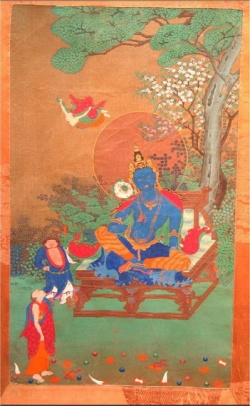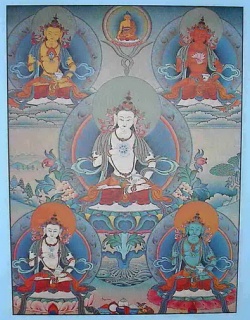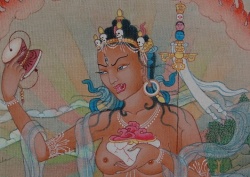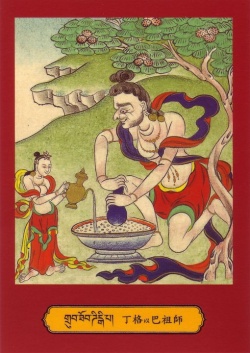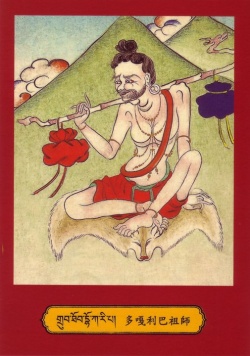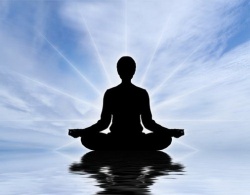The Fountainhead of the Ngakpa Tradition by John Myrdhin Reynolds
NUBCHEN SANGYE YESHES
- Fountainhead of the Ngagkpa Tradition
- The text of the bSam-gtan mig-sgron, attributed to Nubchen Sangye Yeshe (gNubs-chen Sangs-rgyas ye-shes, 9th cen. CE), contains an exposition of the four kinds of Buddhist teaching prevalent in Tibet in the eighth and ninth centuries.
- Even in these early times, Lama scholars clearly distinguished the view of Ch'an or Zen Buddhism from that of Dzogchen. These four types of Buddhist teaching were the gradualist path of the Mahayana Sutras, otherwise known as Madhyamaka, the non-gradualist path of the Sutras, that is to say, Ch'an or Zen, the gradualist path of the Mahayoga Tantras, and the non-gradualist path of Dzogchen Upadesha. In chapter seven, Nubchen provides a detailed exposition of Dzogchen and clearly indicates the close connections between Dzogchen with the Mahayoga Tantras.
- The emphasis in this presentation of Dzogchen here is placed on the viewpoint of the Primordial Base (ye gzhi) which is characterized as being primordially pure (ka-dag). By way of exposition, Nubchen cites nine different views (lta-ba dgu) regarding Dzogchen held by leading masters of Dzogchen from Uddiyana, India, and Tibet. Nubchen associates his own view of the Natural Base of all phenomena which exists just as it is (chos thams-cad gzhi ji-bzhin-pa'i lta-ba) with that held by Garab Dorje and king Dahenatalo of Uddiyana.
- The author of the bSam-gtan mig-sgron identifies himself as gNubs-ban and this is surely Nubchen Sangye Yeshe. He goes on to state that he had studied under various Indian and Nepali masters, and in particular with the Gilgit (bru-sha) translator Chetsunkye (lo-tswa-ba Che-btsun-skyes), who was largely responsible for translating the Anuyoga Tantras into Tibetan. These texts, under the designation rNal-'byor grub-pa'i lung, are much quoted in Nubchen's work. Some near contemporary critics, like Prince Zhiwa-od (Pho-brang Zhi-ba 'od, 10th cen. CE), accuse Nubchen of actually composing Nyingmapa Old Tantra texts himself and then passing them off as translations of indian originals.
But the contents of the bSam-gtan mig-sgron show its author to be a scholar and a thinker aware of subtle philosophical distinctions. Later Nyingmapa tradition portrays Nubchen as a black-hat magician, a Tantrika (sngags-pa) indulging in the performance of black magic rites (drag-sngags, fierce mantras), and it is said that he was able to terrify and intimidate king Langdarma by means of his sorceries. However, there is no contradiction in his being both a scholar of philosophical bent and a magician; such was the case with several well-known figures of the Renaissance period in Europe.
- According to the Nyingmapa tradition, Nubchen was born into the clan of Nub (gNubs) in the Drak Valley. At the young age of seven he became a master of the Tantras and received from Guru Padmasambhava the initiations for the sGrub-pa bka'-brgyad, the Sadhana Practices of the Eight Herukas. During the course of the initiation ceremony, when he tossed a flower into the Mandala of these Eight Herukas, it fell into the region of the Mandala associated with the residence of Yamantaka (gshin-rje gshed), the wrathful aspect of Manjushri, the Great Bodhisattva of Wisdomo manifests dark indigo in color, having a horned buffalo head. After practicing the sadhana of Yamantaka for twenty-one days, he received a vision of the terrifying face of that meditation deity. Thus, Yamantaka became his yidam, or personal meditation deity that forms the basis of one's practice, and the glorious Bodhisattva Manjushri himself bestowed upon the boy a prodigious memory and a supreme intelligence. When he grew to adolescence, by means of his magical powers acquired through Yamantaka practice, he destroyed the compounds of thirty-seven warring hostile villages in Drak district and drove back their armed men with magically conjured fire.
Indeed, through his meditation practice, he became the consummate master of the Fierce Mantras (drag-sngags), the black magic that destroys the enemies of the Dharma. In the cave of Drag-yang-dzang, his purpa, or three-bladed magic dagger, pierced the solid rock of the cliffside as if it were butter. It is said that Nubchen afterwards visited India, Nepal, and Gilgit, where he directly received teachings and secret instructions from Shrisimha, Vimalamitra, Shantigarbha, Dhanashila, Vasudhara of Nepal, and Chetsunke of Gilgit; and in Tibet he received esoteric teachings from Nyag Jnanakumara, Sogpo Palgyi Yeshe, and Zhang Gyalwe Yontan. Thus, all the lineages of transmission for Mahayoga, for Anuyoga, and for Dzogchen Semde converged in him.
- When in the ninth century, King Langdarma and his hostile ministers set about to suppress the Indian Buddhist teachings and to close the Buddhist monasteries such as Samye, he summoned the Tantric master Nubchen Sangye Yeshe and his disciples into his presence, although all of them were not Buddhist monks but rather Tantrikas (sngags-pa). The arrogant king challenged Nubchen, inquiring, "And what power do you have?"
- "Just observe the power I can manifest merely from the reciting of mantras!" Nubchen replied and raised his right hand in the threatening gesture of tarjini-mudra.
- Instantly, in the sky above the Tantric sorcerer, the king saw nine giant scorpions appear, each the size of a wild yak. The king was terrified at this vision. So he promptly promised not to harm the white-robbed Buddhist Tantrikas and to refrain from disrobing and exiling them as he had done with the maroon-robbed Buddhist monks. Then Nubchen pointed again into the sky with a threatening gesture, and lightning flashed from heaven, shattering into pieces a nearby boulder.
- Doubly terrified, the king vowed, "I will not in any way harm you or your white-robbed followers!" and he ordered that his prisoners be released. because of the mighty magical powers of this Tantrika Nubchen, the anti-Buddhist king could not destroy the esoteric teachings of the Mahayoga Tantras nor their white-robbed practitioners, the Ngakpas (sngags-pa, one who uses mantras). Subsequently, this Tantric Order of Nyingmapa Buddhists has flourished among the Tibetans until this day.
- Most people in the West assume that all Lamas are necessarily monks. This is not actually the case since the Tibetan word Lama (bla-ma), used to translate the Sanskrit term "guru", means a spiritual teacher, and that may be either a monk or a layman. Nevertheless, monasticism and the life-style of the monk has always been the principal form of Buddhism institution and social organization wherever Buddhism has spread in Asia.
- This Buddhist monastic culture was introduced into Tibet from India in the seventh and eighth centuries of our era, and revived again in the eleventh century after a temporary eclipse. The Indian Buddhist scholars brought with them to Tibet and exceptionally rich and profound thousand year old spiritual culture, and whereas this culture largely disappeared from India itself in the thirteenth century due to the total destruction of the great Buddhist monastic universities of Northern India by rampaging invading hordes from Afghanistan and Central Asia bent on pillage, loot, rape, and the forcible conversion of conquered native populations to the ascendant religion of Islam, much of the intellectual heritage of these universities, lost in India, was preserved in Tibet.
- During these early centuries the Tibetan government sponsored one of the greatest translations projects ever undertaken in history-- translating the bulk of texts of Mahayana Buddhism from the Sanskrit language into Tibetan. But although this monastic culture of monks and monasteries has been throughout the past 2500 years the principal social institution for the preservation and the transmission of the Buddhist heritage, that there have existed other forms of Buddhist teaching and practice.
- Even in the time of Shakyamuni Buddha himself, not all of his principle followers were monks. One example is the layman and merchant Vimalakirti who could defeat in debate on the subject of Shunyata or emptiness the great monk scholar Shariputra himself. Scholars such as E. Lamotte and E. Conze have speculated that the tension between the saffron robbed Elders of the monastic community and the white garbed leaders of the Buddhist lay community, was one factor in the historical development of the Mahayana. Only a century after the passing away of the Lord Buddha, at or around the council at Vaishali there was a schism between the Sthaviras or Elders and the Mahasanghikas or adherents of the Greater Assembly, which included many leaders who were not monks.
Whereas the traditions preserved among the Sthaviras or elder monks evolved into the eighteen schools of Hinayana Buddhism, which asserted that in order to attain liberation from the cycle of rebirth one must first be reborn as a male and second become a monk, the Mahasanghikas held the enlightenment was open to everyone, male or female, monk or lay-person, because each individual possessed an inner disposition to enlightenment. This community of the Mahasanghikas was the matrix out of which the later Mahayana grew-- but both Sthaviras and Mahasanghikas possessed authentic traditions that went back to the historical Buddha himself, although their emphases differed. In the Mahasanghika-Mahayana tradition it was possible for the layman or the laywoman to be a full-fledged practitioner of the Buddha Dharma, and not just a second rate citizen of the Sangha in relation to the ordained clergy of the monks.
- But most important historically for the development of Buddhism in Tibet was the Mahasiddha Tradition that evolved in North India in the early Medieval Period (3-13 cen. CE). Philosophically this movement was based on the insights revealed in the Mahayana Sutras and as systematized in the Madhyamaka and Chittamatrin schools of philosophy, but the methods of meditation and practice were radically different than anything seen in the monasteries. The Sanskrit term Mahasiddha means a great adept. A Siddha or adept is an individual who, through the practice of sadhana, a spiritual and psychic discipline or process of realization, attains the realization of siddhis, psychic and spiritual powers.
These methods were revealed in Buddhist scriptures known as Tantras. Sometimes their source is said to be the historical Buddha, but more often it is a transhistorical aspect of the Buddha called Vajradhara who reveals the Tantra in question directly in a vision to a specific Mahasiddha. This vague and ill defined community of Mahasiddhas was the historical matrix for the revelation of the Higher Tantras, the Anuttara Tantras. They broke with the conventions of Buddhist monastic life of the time, and abandoning the monastery they practiced in the caves, the forests, and the country villages of Northern India. In complete contrast to the settled monastic establishment of their day, which concentrated the Buddhist intelligentsia in a limited number of large monastic universities, they adopted the life-style of itinerant mendicants, much the wandering Sadhus of modern India.
- The form of ascesis expounded in the Tantras, unlike the Sutras and the Vinaya which taught the methods of the path of renunciation, taught the methods of transformation, where the poisons of the passions, far from being renounced were actually cultivated to their extreme, in order that their energy might be transmuted within the alchemical vessel of the physical human body into the luminous nectar of enlightened awareness. There was a deliberate and clear parallel here with alchemy-- the kleshas or passions through the alchemical process of sadhana were transmuted into Jnana (gnosis) or knowledge.
Thus the things of the world that are usually renounced by the ascetic-- wine, meat, and sex-- which are seen as the fetters binding the spirit to matter and nature, especially the latter (women and sex) are not renounced in the higher Tantras but actually employed as the very means to enlightenment. But this was not an excuse or rationale to party with wine, women, and song-- it represented a highly disciplined ascetic path. And since the methods of the Tantra principally works with energy, and one of the most important and powerful energies in human experience is sex desire, a sophisticated sexual yoga developed, known as Upayamarga and as Karmamudra.
Yoga practitioners took consorts or sexual partners from among the village girls, including even outcaste girls, such as Dombhis, Chandalis, etc. and lived with them in retreat or in the villages while plying humbles trades. For example, the young Brahman scholar Saraha defiled his caste status by living openly with a low caste who was an arrow-maker, yet he is considered one of the greatest poets and scholars of the Buddhist Tantric tradition. Or Naropa, once a professor and chancellor at Nalanda monastic university, abandoned his academic career to pursue the teachings of Tilopa, a wild-eyed and apparently half-mad ascetic who lived in a series of remote cremation grounds in the company of women of questionable virtue. In India generally the Anuttara Tantras were not practiced in the monasteries because their practice was incompatible with the Vinaya, the rules and vows incumbent upon a monk. At first this was also the case in Tibet.
- This tradition which existed outside of but parallel to the monastic discipline, was brought to Tibet in the eighth century by such accomplished Mahasiddhas as Padmasambhava and Vimalamitra and readily adopted as the principal practice in non-monastic Tantric circles led by such individual as Nubchen Sangye Yeshe (gNubs-chen sangs-rgyas ye-shes, 9 cen. CE), who in contrast to the monks at Samye monastery went about in the guise of a Bonpo black hat sorcerer. Nubchen was a married Lama, and he was not only a Tantric sorcerer and magician, but a learned scholar and translator.
However, his work and the studies and translations of the Mahayoga Tantras (the technical designation for the Higher Tantras in the early period) of others like him went on out side of government control and sponsorship. Basically the translation and practice of the Sutras and the Vinaya, and to a very limited extent certain Lower Tantras, was all that was sanctioned and financed by the Tibetan government. This represented an official Buddhism. But the Higher Tantras, the Mahayoga Tantras (early period) or Anuttara Tantras (later period) represented something of an outlaw or underground movement at first.
The antinomian and libertine Gnostic sentiments of the Tantras and especially the abundant sexual symbolism (deities copulating, exhortations to practice incest, etc.) were calculated to offend the sentiments of polite society. It was not that the Tibetan were puritanical as such; in Tibetan culture sex is not something evil. It is a natural appetite like hunger and thirst, and to be freely indulged without any guilt. But sexual expression in public is discouraged, so at first images of copulating deities were not to be publicly displayed. Even in India, were erotic symbolism was not so restricted, the Tantras were pre-eminently an esoteric tradition. But even there much of what was expressed in the Tantra was there for its shock value-- it is part of the method of the Tantras to take the individual beyond his limitations. to break through all social and monastic conventions. Therefore the abundance of antinomian statements that would shock the conventional morality of the Brahman priest and the Buddhist monk-- all this put into the mouth of the Buddha. No wonder that in the Guhyasamaja Tantra when the assembly of monks hear the real teaching of the Buddha announced, they faint dead away in horror.
- One might almost think of these Tantras as teaching a kind of Buddhist Satanism: the invocation of and worship of a horned and hairy deity called a Heruka, copulating with his goddess consort, who eats raw flesh and drinks blood while making thunderous sounds, surrounded by nocturnal rites and orgies by male and female naked celebrants singing and dancing, a veritable Witches' Sabbat. In the West in past centuries this was the perverse fantasy of celibate clerics and paranoid authorities-- a dark conspiracy against God and civil authority. Burning of heretics and culminated in the witch persecutions in which up to nine million people are said to have perished, burned at the stake or hanged. But the context in Buddhism and the use to which this chthonic and lunar symbolism is put is quite different. Here the aim is not to overthrow the established church or the government of the king, but the ignorant tyranny of the ego, the false God and the false king. This lunar and chthonic symbolism of the Heruka, the Horned God, and the Witches' Sabbat is integrated into the spiritual path to enlightenment. What the whole world condemns becomes the very means to enlightenment. The forbidden fruit is tasted. And the method here is alchemical transformation.
- The Higher Tantras were underground in the early days, but translations were made, despite the lack of government sanction and sponsorship. And transmissions were received from Tantric masters who came to Tibet, such as Guru Padmasambhava in the eighth century who taught the Tantric system of the Eight Herukas (bka'-brgyad), as well as Dzogchen. Three of these Herukas were worldly and concerned with magic: the Worldly Gods, the Mamo mother goddesses, and the Fierce Mantras. In their mandalas Padmasambhava even incorporated native Tibetan deities in a subordinate role. But he gave these initiations in a cave at Chimphu and not in the nearby recently erected monastery of Samye. The cult of the Higher Tantras was not practiced publicly. Wall paintings from these early centuries depict the peaceful deities of the Yoga Tantras but not the wrathful blood-drinking and copulating deities of the Anuttara Tantras.
- When Buddhism was persecuted in Tibet in the ninth century after the assassination of the Buddhist king Ralpachan, it was only the monasteries and the monks that were suppressed. The faction in the government responsible for the coups was not anti-Buddhist as such (a later anachronistic interpretation) but felt that the monks were social parasites and that the monasteries represented too great a drain on the royal treasury at a time when foreign wars needed to be prosecuted to preserve the Tibetan empire in tact. Individual Tantrikas or Tantric practitioners like Nubchen Sangye Yeshe continued their work and teachings privately without government interference. Although historical records a few and scanty, this period, the ninth and tenth centuries. is the seminal age for what subsequently became known as the schools of Nyingmapa and Yungdrung Bon.
- Then in the eleventh century there was a revival of monastic Buddhism in Central and Western Tibet, initially under official government sponsorship in the Western Tibetan kingdom of Guge. Inscription there of the royal monks Lhalama Yeshe-od and his kinsman Dawa-od attack and condemn Dzogchen and the Mahayoga Tantras, especially what is called sbyor-grol. sByor-ba refers to the practice of sexual yoga and sgrol-ba to the killing of a living being in a ritual manner without incurring any negative karma. But in general, the Buddhist Tantras, unlike the Hindu Tantras associated with the cult of the goddess Kali, do not involve actual blood sacrifice, although that symbolism may be employed. Both Buddhism and Yungdrung Bon, unlike tribal shamanism, categorically reject and condemn the practice of the red offering (dmar mchod) or blood sacrifice.
But sex is a different matter altogether. The Mahasiddhas in India and initially their followers in Tibet practiced sexual yoga, not just symbolically but actually. This however, scandalized many Tibetans who accused these Lamas of fornicating in the temples. When the great Indian Tantric master and scholar Atisha was invited to Guge in Western Tibet in the eleventh century his own chief disciple Dromton forbade his master to teach the Higher Tantras, claiming that the Tibetans would inevitably misunderstand their antinomianism and their sexual symbolism. Dromton founded the first distinct school of Tibetan Buddhism, the Kadampa, which was noted for its stress on the Vinaya or monastic discipline.
- The Tibetan disciples of Atisha as well as other Tibetans, some of whom went to India for studies, began building monasteries. In general Tibetans think that Buddhism only exists when there are monks and monasteries, that is, a social institution or church which serves as the base for the transmission of the Buddhist teachings. But outside the monasteries and soon inside them the Mahasiddha Tradition continued to flourish and grow. The principal reason for this was that the Indian Buddhism of the time had become more and more dominated by Tantric practice. It was impossible for any of the Tibetan reformers, despite the new puritanism of the eleventh century to deny that the Higher Tantras were the word of the Buddha. The Higher Tantras were all the fashion in India and were taught to their Tibetan disciples by Indian masters such as Naropa, Maitripa, Atisha, and so on. And so a reapproachment had to be made.
- The Higher Tantras could not be a congregational practice of monks because Tantric sadhana, as well as celebrations of the High Tantric feast or Ganachakrapuja, required partaking of meat, wine, and sexual intercourse. At the very least the latter two would force a monk to break his vows. And so what came about in the eleventh century was a change in the external style of practice; the Anuttara Tantras, many of them freshly brought from India and newly translated into Tibetan, came to be practiced in the style of the lower Yoga Tantras. Although there is a great deal of ritual in the Yoga Tantras, there is nothing there that would require a monk to violate his monastic vows.
The presence of a woman or Dakini is require at High Tantric initiation and also at the Tantric feast of the Ganachakrapuja, but in the eleventh century reform the actual Dakini physically present was replaced by a mind-consort (yid kyi rig-ma), a visualization of the Dakini. One did the sexual practice only in visualization, not in actuality. In this way the practices of the Higher Tantras could be taken into the monasteries and incorporated into the congregations practice and liturgy of the monks known as puja. Unlike the Zen Buddhists of Japan, Tibetan monks customarily do not practice group meditation. That is something done in the privacy of one's room or in a retreat situation. The typical congregational practice of Tibetan monks is puja which may involve the chanting of liturgies and the making of offerings for many hours. Partaking of a little wine or meat during Ganapuja is allright because in the course of the ritual they have been mystically transmuted into nectars, and the holy red and white substances in the skull cup have been replaced by symbolic substitutes. But if one were to read the text of the liturgy, they are filled with the activities of wrathful deities which are both sexual and sanguine. But otherwise, everything is perfect monastic decorum.
This was so successful a solution to the dilemma that all four schools of Tibetan Buddhism almost exclusively practice the Anuttara Tantras, to the neglect of the Yoga Tantras. Nonetheless, the Yoga Tantra transmissions have been preserved, especially in the Sakyapa school which is quite fastidious about preserving all of the authentic Indian Tantric transmissions. Among the Nyingmapas, who preserve the traditions coming from the early period of the spread of Buddhism in Tibet (7-9 cen. CE), practitioners of the Higher Tantras who do not take monastic ordination and become monks are known as Tantrikas or Ngagpas (sngags-pa), meaning "those who use mantras (sngags)". They are typically married Lamas. A Lama, though functioning as a priest and teacher, is not necessarily a monk.
- But the old pre-Buddhist pagan and shamanic culture of Tibet continued side by side with the growth of this monastic system of Indian origin. Gradually, in all of the schools of Tibetan Buddhism these indigenous magical and ritual practices began integrated with the Buddhist practices of Indian origin, thus giving to Tibetan Buddhism its unique flavor and character which is so different from other forms of Mahayana Buddhism. The Ngakpas like Nubchen Sangye Yeshe, living outside the monasteries and still close to the common people of Tibet, the peasants and the nomads, were especially open to incorporating the native magical tradition into their Buddhism. The same had been done previously in India, incorporating the traditions of popular Indian magic into the Buddhist Tantras, as for example, the Mahakala Tantra.
This was done by both Indian and Tibetan Buddhists for the simple reason that, on the practical level, magic works. Magic is a way of evoking and channeling energy in order to realize certain effects. It does not work with the same efficiency as a mechanical device because its efficacy depends on the state of mind of the practitioner and may other secondary factors, but it works enough of the time to inspire the confidence of most of humanity for most of human history. However, in the West, since the eighteenth century with its mechanistic model of reality and the general fruitfulness of the scientific method and explanations, magic has received a bad press from Western scholars. Western scholars of Buddhism tend to underplay the role of magic in Buddhism, including Theravada Buddhism, and they become upset with the idea that Buddhist Tantra represents an incredibly complex and sophisticated system of theurgy and ceremonial magic.
